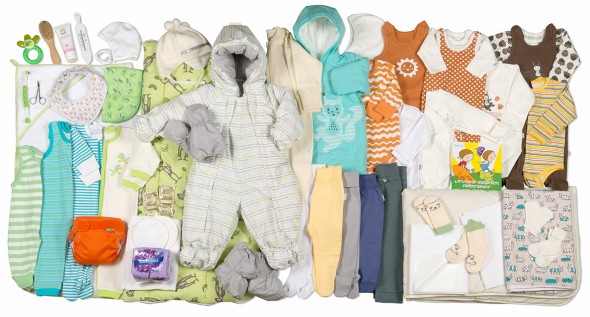Baby-boxes
18 February 2015 | This 'n' that

Contents of the Finnish baby-box. Photo: Annika Söderblom © Kela
Shortly before my first baby was born – ah, all of thirteen years ago, and a bit more – I paid a visit to the baby department of a central London department store.
Surrounded by push-chairs, feeding pillows, milk-expressers, nappy bins, nappy sacks, pink baby-grows, blue baby-grows, and advice books of every persuasion, I felt bewildered. The choice seemed infinite. Surely it couldn’t be this complicated.
I picked up one of the books. ‘6:30 Get up with your baby.’ I don’t think so, I objected inwardly. I’ve never been an early bird. ‘7:30 Breakfast: toast and marmalade.’ Definitely not. No one was going to tell me what to eat, or when. Were they? What on earth was this brave new world of motherhood going to be like?
It was all too much. Overwhelmed, I left the shop. I wasn’t about to let the beautiful, simple relationship I had with the person inside me be ruined by shopping anxiety. Besides, I had an alternative. As a half-Finn, I knew about the baby boxes the Finnish government issued to every new mother. Stocked with everything you need – carefully gender-neutral clothes, mittens, a snow suit, muslins, first nappies, towels, a thermometer, a picture-book – the box itself can even be used as a cot for your new baby. Since I didn’t live in Finland, I wasn’t entitled to get one for free. But I ordered one, and we never looked back.
I liked the things in the box. I liked it that I hadn’t had to choose them. And I liked it that I knew that all the babies born in Finland at the same time as mine had exactly the same things. An equal start in life for everyone, however unequal everything else might be about to become.
Now, the whole world knows about Finnish baby boxes. Three million visitors to the BBC News website read it in the last week of January alone. Ten million in the past three months. And on 28 January it became the first story in the site’s 17-year history to have been shared one million times. Since it was first posted, in June 2013, by BBC correspondent Helena Lee, it has enjoyed three distinct waves of popularity as people circle it, returning to it again and again.
What makes the story so interesting? Is it the egalitarianism that appealed to me, as a new mother? Or the quirkiness of the story? Or the fact that the most active users of social media are themselves of baby-making age?
No one knows. But it’s quite a statistic, for a story about a cardboard box.
No comments for this entry yet
